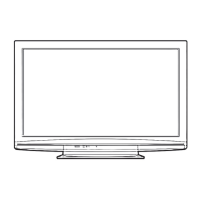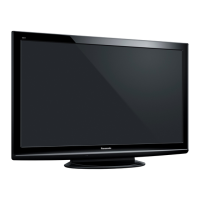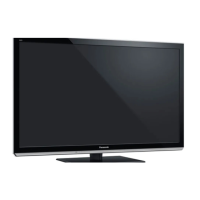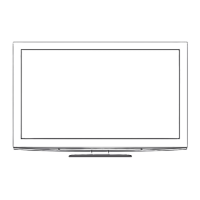
Do you have a question about the Panasonic Viera TX-P42U20B and is the answer not in the manual?
Receives DVB digital terrestrial broadcasts and allows easy channel selection or timer programming.
Utilizes a high definition panel for high definition pictures close to original resolution.
Supports Gemstar-TV Guide sent from the GUIDE Plus+ system.
Enjoy high definition digital picture and high quality sound using an HDMI cable.
Allows viewing of photos or videos recorded on an SD Card on the TV screen.
Supports SDXC Card, the latest standard for higher storage capacity SD cards.
Enables playback of moving pictures recorded on an SD Card in AVCHD format.
Decodes Dolby Digital audio tracks for multi-channel sound output.
Provides easy recording, playback, and home theatre setup via Q-Link and VIERA Link.
Accesses special features like VIERA Link and Media Player easily via the VIERA TOOLS button.
An anti-theft function that uses PIN number and owner's information.
Adds an additional soundtrack to describe on-screen events for visually-impaired viewers.
Warnings and guidelines for safe use of the mains plug and lead to prevent electrical hazards.
Caution regarding small parts that can be swallowed by young children.
Ensuring sufficient space around the TV to prevent excessive heat buildup.
Guidelines for safely moving the TV, emphasizing the need for two people.
Recommendation to remove the mains plug when the TV is not used for prolonged periods.
Warning about potential ear damage from excessive volume, especially with headphones.
Check for included standard accessories like remote control, batteries, and cables.
Information on purchasing optional accessories such as wall-hanging brackets.
Instructions for correctly installing and removing batteries from the remote control.
Step-by-step instructions for assembling the TV's pedestal.
Guidance on securely fastening the TV to the assembled pedestal.
Diagram and explanation of the functions of each button on the remote control.
Instructions on how to navigate and operate the TV using the remote control via on-screen menus.
Diagram showing how to connect an aerial for TV-only reception.
Diagram for connecting a DVD Recorder or VCR to the TV.
Diagram showing connections for DVD Recorder/VCR and Satellite receiver.
Initial step to plug the TV into mains and switch it on for auto setup.
Step to input Owner ID, which includes entering a PIN number.
Choosing between 'Home' or 'Shop' viewing environment.
Instructions for entering a 4-digit PIN number for Owner ID.
Entering name, house number, and postcode for Owner ID.
How to select characters one by one using numeric buttons.
Selecting the 'Home' environment for normal use.
Instructions on how to turn the TV on using the remote or mains switch.
How to select between DVB and Analogue TV reception modes.
Methods for selecting TV channels using numeric buttons or up/down controls.
Selecting channels using the information banner displayed after channel change.
Selecting channels and programmes using the TV Guide (EPG).
Allows freezing or unfreezing the picture.
Shows channel name, programme information, and available features.
How to display or hide subtitles for DVB and Analogue modes.
Adjusting the image aspect ratio manually for optimal viewing.
Adjusting settings like Multi Audio, Monaural Audio, and Subtitle Language.
Switching easily to the previously viewed channel or input mode.
Sets the TV to turn off automatically after a specified period.
Choosing between DVB or Analogue channels to view the TV Guide.
Displaying the electronic programme guide for current and upcoming broadcasts.
Selecting a programme directly from the TV Guide to watch.
Listing channels filtered by categories like All Channels or specific DVB types.
Searching for programmes based on types like Movie, Sport, etc.
Searching for programmes by entering specific titles.
Reminds or records programmes automatically using timer programming in DVB mode.
Timer programming controlled by TV Guide signal, adapting to broadcaster changes.
Viewing detailed information about a selected programme from the TV Guide.
Displaying advertisements based on postcode, requiring TV to be in standby.
Options to change or update advertisement information.
Exiting from detailed views or advertisements back to the main TV Guide screen.
Selecting a DVB channel to access digital teletext services (MHEG).
Activating the teletext service using the TEXT button.
Navigating teletext pages using remote control buttons and on-screen commands.
Accessing analogue teletext services and understanding its features.
Using coloured subjects for fast access to teletext information.
Using coloured page numbers for accessing and storing frequently viewed pages.
Switching between FASTEXT and List modes via the Setup Menu.
Revealing hidden words or answers on teletext pages.
Adjusting the display of teletext pages, including split-screen views.
Stopping automatic updating of teletext pages to hold the current page.
Viewing favourite subtitle pages and managing subtitle services.
Watching TV and Teletext simultaneously in two windows.
Storing frequently viewed teletext pages in the colour bar for quick access.
Changing the stored page numbers for quick access.
Viewing sub pages when teletext has more than one page.
Entering a specific 4-digit number to view a sub page.
Viewing TV while teletext pages are updating in the background.
Turning on the TV when connecting external equipment like VCRs or DVD players.
Accessing the menu to select the input source for external equipment.
Choosing the correct input mode (e.g., AV1, HDMI) for the connected equipment.
Displaying the currently selected input mode.
Using the TV remote to operate functions of connected equipment.
Changing the remote control code to match the type of connected equipment.
Accessing the VIERA TOOLS menu to display feature icons.
Choosing a specific feature like VIERA Link Control, Pause Live TV, Photo, or Video.
Following instructions to operate the selected feature.
Accessing and navigating the TV's main menu system.
Choosing specific items within a menu for adjustment or configuration.
Adjusting settings using slide bars, choosing from alternatives, or free input.
Using the on-screen keyboard or numeric buttons to enter text.
Selecting picture modes like Dynamic, Normal, Cinema, True Cinema, or Game.
Adjusting the overall colour tone of the picture (Cool, Normal, Warm).
Resetting the current Picture Viewing Mode to its default settings.
Selecting basic sound modes (Music, Speech, User) and adjusting Bass/Treble.
Enabling or adjusting Audio Description for visually-impaired viewers.
Resetting Sound Mode, Balance, Headphone Volume, and Surround to defaults.
Configuring VIERA Link, Q-Link, Standby Power Save, and Q-Link Download.
Managing DVB channels including Auto Setup, manual tuning, and channel lists.
Managing Analogue channels, including Auto Setup and manual tuning.
Configuring Teletext display modes (FASTEXT/List) and preferred subtitles.
Adjusting side panel brightness, input labels, and banner display timeout.
Accessing system settings like Shipping Condition, Owner ID, and System Update.
Setting postcode and system information for the GUIDE Plus+ service.
Configuring power-on preferences, auto standby, power save, and DVI input.
Initiating the channel retuning process for DVB channels.
Performing automatic channel search and storage for DVB channels.
Initiating the channel retuning process for Analogue channels.
Performing automatic channel search and storage for Analogue channels.
Sorting DVB channels based on signal quality or preferred region.
Manually setting DVB channels or adjusting aerial direction.
Creating and managing lists of favourite DVB channels.
Hiding unwanted DVB channels from the channel list.
Editing existing DVB channels in the channel list.
Manually setting Analogue channels after Auto Setup.
Automatically updating the DVB channel list with new channels and names.
Checking the signal quality and strength for DVB reception.
Initiating the channel tuning process for Analogue channels.
Revealing or hiding specific Analogue channels in the list.
Editing Analogue channels, including moving positions and renaming.
Manually tuning Analogue channels, potentially setting position '0' for VCR connection.
Introduction to using Timer Programming for reminders or recordings.
Choosing between DVB or Analogue tuner for timer programming.
Steps to access the Timer Programming menu via the Setup menu.
Setting up timer events including reminders and external recordings.
Initiating the process to set timer programming event details.
Choosing between 'Reminder' to watch or 'Ext Rec.' to record.
Inputting channel number, date, start time, and end time for the event.
Saving the configured timer programming event.
Changing or cancelling existing timer programming events.
Viewing details for Guide link programming events.
Navigating to the Child Lock menu via Setup > System Menu.
Locking specific channels or AV inputs to control viewing.
Entering the PIN number to unlock locked channels or inputs.
Choosing specific channels or inputs from the Child Lock list to lock.
Option to change the existing Child Lock PIN number.
Navigating to the Input Labels menu within Display Settings.
Naming or skipping input terminals for easier identification and selection.
Entering custom names for input terminals using on-screen keyboard.
Navigating to the Shipping Condition option in the System Menu.
Confirming the reset of all TV settings to factory defaults.
Completing the factory reset process as guided by on-screen messages.
Navigating to the Owner ID setup section in the System Menu.
Entering PIN, name, address, and postcode for owner identification.
Option to change the Owner ID PIN number.
Selecting DVB mode to access the Common Interface module.
Accessing the Common Interface menu via Setup > System Menu.
Accessing pay-TV features contained on the Common Interface module.
Following specific on-screen instructions provided with the CI module.
Navigating to the System Update section in the System Menu.
Setting the TV to automatically search for and download software updates.
Manually initiating a search for and download of TV software updates.
Viewing still pictures from an SD Card using the VIERA IMAGE VIEWER.
Instructions for correctly inserting and removing SD cards from the TV.
Launching the Photo mode of the Media Player to display .jpg files.
Viewing photos one at a time, with options for rotation and information display.
Playing photos automatically in a slideshow sequence.
Customizing photo mode settings like background music, frame, and colour effect.
Sorting media files by folder, recorded date, or recorded month.
Viewing thumbnails of selected groups of photos after sorting.
Introduction to Video mode for playing AVCHD and MPEG2 file formats.
Playing back video files from the title view, with preview options.
Playing back specific scenes from video files.
Controlling video playback with functions like rewind, pause, fast forward, and stop.
Confirming or changing the current sound status during media playback.
Selecting initial settings for digital audio output signal (Auto/PCM).
Choosing settings for video mode playback, including preview and repeat options.
Switching from Video mode back to Photo mode within the Media Player.
Introduction to Q-Link function for connecting TV and DVD Recorder/VCR.
Introduction to VIERA Link for controlling HDMI-connected equipment.
Summary table of features available for Q-Link and VIERA Link connections.
Details on VIERA Link features for various equipment connected via HDMI or Audio out.
Diagrams illustrating connections for Player theatre, Amplifier, and DIGA Recorder.
Information on compatible equipment and maximum number of controlled devices.
Preparations for Q-Link connection, including cable requirements and setup.
Downloading analogue channel settings to a recorder with an analogue tuner.
Recording the current programme on a DVD Recorder/VCR immediately.
Enabling TV to automatically turn on/off connected recorders.
Connecting equipment supporting VIERA Link and setting up the TV.
Features like analogue channel download and easy playback via VIERA Link.
Automatic power on/off linkage between TV and connected equipment.
Using Standby Power Save to control connected equipment's standby power consumption.
Recording programmes directly using VIERA Link menu and Direct TV Rec function.
How to stop the Direct TV Recording process and unlock the tuner.
Pausing and resuming live TV programmes, recorded on the DIGA Recorder's HDD.
Steps to access and pause the live TV programme via VIERA Link menu.
Using remote controls to manage Pause Live TV playback and operations.
Stopping playback or cancelling the pause to return to the live TV broadcast.
Using the TV remote to control menus of connected equipment.
Selecting the type of equipment to access its menu via VIERA Link.
Choosing the specific equipment (e.g., Recorder, Player) for remote control.
Using the TV remote to control home theatre speaker volume.
Selecting audio output between home theatre speakers or TV speakers.
Diagrams showing recommended connections for various external equipment.
Table outlining which equipment can connect to which TV terminal.
Information on connecting HDMI-compatible equipment for high-definition AV.
Connecting headphones and adjusting volume via the Sound Menu.
Instructions for installing the supplied ferrite core on cables.
Connecting DVD Recorders or VCRs for recording purposes.
Automatically choosing the optimum size and aspect ratio for finer images.
How auto mode determines the best aspect ratio using WSS, control signals, and letterbox detection.
Important precautions for handling SD cards to prevent damage or data loss.
Information on supported file formats for Photo (JPEG) and Video (MPEG2, AVCHD).
Details on compatible SD card types (SDXC, SDHC, SD) and their formats (exFAT, FAT).
Table showing characters that can be entered using numeric buttons.
Pinout details and signal information for AV1 and AV2 SCART terminals.
Pinout details and signal information for HDMI terminals.
Information on HDMI features like Linear PCM audio and various video signal formats.
Connecting equipment with a DVI output using a DVI to HDMI adapter cable.
List of supported input signal formats for COMPONENT and HDMI terminals.
Details on input signal formats and frequencies for PC connection via HDMI.
Troubleshooting for digital noise, ghosting, and untuned channels.
Steps to resolve problems where there is no image or sound output.
Troubleshooting for problems with Q-Link and VIERA Link functions not working.
Explanation for reduced contrast occurring under specific conditions.
Resolving noisy images by checking P-NR and nearby electrical products.
Troubleshooting steps for when no image is displayed on the screen.
Addressing low or distorted sound by checking NICAM and signal reception.
Troubleshooting steps for channels not being found or channel number changes.
Troubleshooting for the TV not switching on or entering standby mode.
Resolving problems with the remote control not working or being intermittent.
Guidance on responding to error messages displayed on the TV screen.
Interpreting messages related to channel tuning, resets, and signal conditions.
Understanding messages regarding timers, software updates, and feature availability.
Interpreting messages related to recording status, service availability, and channel status.
Messages indicating incorrect PIN entry or connection issues with HDMI devices.
Troubleshooting messages related to SD card reading, file playback, and operations.
Guidelines for cleaning the TV's display panel, cabinet, and pedestal.
Instructions for cleaning the mains plug to prevent fire or electrical shock.
Definitions of technical terms used throughout the manual.
Specifications for power source, rated consumption, and standby power consumption.
Details on aspect ratio, screen size, and number of pixels.
Information on TV receiving systems, aerial input, and connection terminals.
Specifications for operating temperature, humidity, and the TV's mass.
Information on proper collection and disposal of used electrical products and batteries.
Contact information for customer care, product support, and accessory orders.
Space for recording model number, serial number, and purchase details for warranty purposes.









